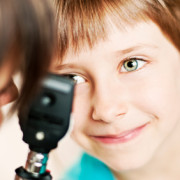Amblyopia
Amblyopia is a disorder of the visual system that is characterized by poor or indistinct vision in one or both eyes that is otherwise physically normal. The brain and the eye work together to produced vision: Light enters the eye and is focused on the retina. The retina changes light into nerve signals that travel along the optic nerve to the brain (visual cortex). The medical term for the connections between the eye and the brain not working properly is amblyopia. The eye itself looks normal, but the brain does not interpret normal vision. Putting on glasses (without treatment) will not produce 20/20 vision.
How common is amblyopia?
Amblyopia is the most common cause of visual impairment in childhood. It affects about 5% of the population. Unless it is successfully treated in early childhood, amblyopia persists into adulthood, and is the most common cause of monocular (one eye) visual impairment.
What causes amblyopia?
Amblyopia may be caused by any condition that affects normal visual development or use of the eyes. Amblyopia can be caused by:
- Strabismus, an imbalance in the positioning of the two eyes
- Excessive farsightedness or astigmatism
- Unequal prescription between the two eyes
- Opacities such as cataracts
How is amblyopia treated in children?
Treating amblyopia involves making the child’s brain use the eye(s) with the reduced vision. The best outcome is achieved if treatment is started before the age of five. Currently, there are two ways used to do this:
- Glasses (correcting the optical defect)
This is treatment of hyperopia, myopia, and/or astigmatism through the use of full-time glasses. This stimulates vision development in the brain.
- Occulusion (patching)
An opaque patch is worn over the stronger eye for months to a year, forcing the brain to use the amblyopic eye. Patching forces the brain to use the visual cortex designated to the weaker eye to develop normal vision.
More than you ever wanted to know about Amblyopia:
Physiology:
Amblyopia is a developmental problem in the brain; the part of the brain corresponding to the visual system from the affected eye is not stimulated properly, and develops abnormally. This has been confirmed via direct brain examination. David H. Hubal and Torsten Wiesel won the Nobel Prize in Physiology or Medicine in 1981 for their work demonstrating the irreversible damage to ocular dominance columns produced in kittens by sufficient visual deprivation during the so-called “critical period”. The maximum critical period in humans is from birth to two years old. The problem is caused by either no transmission or poor transmission of the visual image to the brain for a sustained period of dysfunction during early childhood. Amblyopia often affects one eye, but it is possible to be amblyopic in both eyes if both are similarly deprived of a good, clear visual image. Detecting the condition in early childhood increases the chance of successful treatment.
Symptoms:
Many people with amblyopia, especially those who are only mildly so, are not even aware they have the condition until tested at older ages. Amblyopes even after being treated to 20/20 may suffer from poor spatial acuity, low sensitivity to contrast and some “higher level” deficits to vision such as reduced sensitivity to motion. These deficits are usually specific to the amblyopic eye, not the unaffected “fellow” eye. Amblyopes also suffer from problems of binocular vision such as limited stereoscopic depth perception and usually have difficulty seeing the three-dimensional images in hidden stereoscopic displays such as autostereograms. However, perception of depth form the monocular cues such as size, perspective and motion parallax is normal.
My Story: (since many patients ask)
At 5 months of age, my mother noticed occasionally that one of my eyes was slow to follow. The first 4 doctors told her she was an uptight first time mother. The fifth doctor said, yes one eye was more farsighted and had astigmatism. My mother often questioned the eye doctor, since I was reading at age 3, why I needed to come back every 3 months to monitor the vision. Since I had to wear the heavy glass lenses in the 1970’s, I now hold back and prescribe glasses reluctantly. Still today, both my parents, my younger sisters, and all 3 kids see better than 20/20 without glasses. My oldest daughter slipped from 1 line better than 20/20 down to 20/20 so we did glasses at age 4; one hour a day for one month and she returned to 20/15.
National Eye Institute-Supported Research
A Randomized Trial Comparing Part-Time (6 hours a day) Versus Minimal-time Patching (2 hours a day) for Moderate Amblyopia was conducted to determine whether the visual acuity improvement obtaining with part-time patching is equivalent to the visual acuity improvement obtained with minimal patching for moderate amblyopia. Recend findings show that patching the unaffected eye of children with moderate amblyopia for two hours daily works as well as patching the eye for six hours when combined with a minimum of 30 minutes of near work. Shorter patching time should lead to better compliance with treatment and improved quality of life for children with amblyopia. Watching TV, playing video games, or using the computer did not enhance visual development but worked well as rewards to wearing a patch. Thirty minutes of near work can include reading books, puzzles, colouring, crafts, mazes.
 Dr. Selena Friesen, Optometrist
Dr. Selena Friesen, Optometrist
Waverley Eye Care
Winnipeg, Manitoba


